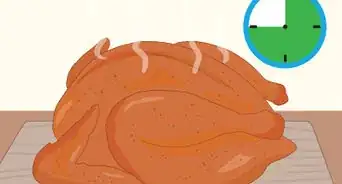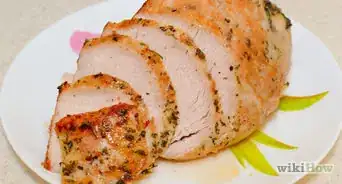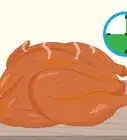This article was co-authored by wikiHow Staff. Our trained team of editors and researchers validate articles for accuracy and comprehensiveness. wikiHow's Content Management Team carefully monitors the work from our editorial staff to ensure that each article is backed by trusted research and meets our high quality standards.
This article has been viewed 251,115 times.
Learn more...
Basting is the process brushing, pouring, or spooning liquid over a food to make it moist and juicy from top to bottom and to give it a wonderfully golden look when cooked. While it isn't 100% necessary anymore like it used to be in grandma's day, it's still a quintessential image and tradition when you think of turkey.
Steps
Prepping Your Turkey for Basting
-
1Prepare your turkey for roasting. This includes de-frosting it, washing, stuffing, and trussing, etc.[1] Want some ideas? wikiHow is full of 'em.
- How to Roast a Turkey
- How to Brine, Truss, and Roast a Turkey
- Slow Cook a Turkey
- How to Roast a Turkey With Moist White Meat
-
2Turn on the oven and place the prepared turkey in its large roasting pan. If you have one available, place the turkey on a rack in the pan so the drippings fall to the bottom of the pan and are easy to get to.
- Some people choose to baste from the drippings in the bottom of the pan, while others choose to make a special mixture separately to put over it. What you use to baste is up to you.
Advertisement -
3Set your timer, and let the roasting begin. You'll want two timers: one for the basting intervals and one for the whole time. How long you put it in for overall largely depends on the size of your turkey.
- Set your basting timer for 30 minutes. You will be basting at every 30 minute interval.
-
4After 30 minutes, open the oven to baste. Pull out the rack part-way. Open the roasting pan lid, or pull back the foil tent cover a bit. Look at the meat. Is it starting to get a little tan? Excellent. Your turkey is ready for its first basting session.
- Some people do prefer to baste every 20 minutes or so. However, the shorter the interval, the more you'll be strapped to the oven.
Basting Your Turkey
-
1Take out a spoon, cup, or bulb baster. A bulb baster is a special rubber tool to suck up and pour out liquids. It's like a large, soft syringe. If you don't have one, a spoon or cup will work just as well.
-
2Baste your turkey. Take some of the liquid you prepared for basting and pour it gently all over the surface, using your spoon, cup, or bulb baster. Use any kind of stock, wine, butter, oils, gravy, or juices. The idea is to keep the turkey meat moist.[2]
- It's easiest to use the juices at the bottom. However, if you have a recipe for an herb butter, a marinade, or a gravy, that's great, too.
-
3Put the lid or tent cover back on, and put the turkey back in to roast. Reset the timer for 30 minutes. Go watch an episode of your favorite TV show or pick up a book, but don't go too far away!
-
4Repeat this process of checking and basting with your reserved liquid every 30 minutes. Soon, once again, you will have liquid on the bottom of the pan. Now use that instead of any liquid from a bowl. Whether you used the original meat juices or something else, it is now at the bottom of the pan, infused with meat juices, ready to be reused again.
-
5Remove extra liquid if the juices touch the bottom of the turkey. Don't let the turkey stew in juices. This will make the meat soft instead of giving it that golden outside, crispy rind.
- This is why a small rack in the roasting pan is best. With a rack, it stays out of all the juices.
-
6But keep the juices! Use some of the juices as a gravy base, or pour some into a bowl for table dressing over stuffing, vegetables, potatoes, etc. Don't let it go to waste! That juice has been stewing for hours with delicious turkey juices.
Using Basting Alternatives
-
1Make a foil tent. Many people choose to forgo the basting entirely and instead wrap the turkey in a foil tent – basically just a layer of aluminum foil loosely over the turkey. This keeps the juices in, serving the same purpose as the basting.[3]
- This is more convenient in that once the foil is placed, you can set it and forget it, instead of going into the kitchen every half hour for maintenance.
-
2Spray with apple juice. Instead of getting into the pan and dealing with hard-to-get-to juices or melting butter and herbs and getting sticky, just spray the turkey with apple juice! If you have a spray bottle, it's incredibly convenient.[4]
- Of course, you could always infuse the apply juice with honey, herbs, butter, or anything else you can imagine for a more savory touch.
-
3Use bacon. Want to put a trendy take on your turkey? What's better than bacon? Fry up some bacon, add in some paprika, garlic, or maybe some onion, and keep the juices. Set the bacon aside on paper towels to dry. Then pour the bacon juices all over the turkey.
- When the turkey is near done, chop up the bacon and sprinkle it over the turkey.[5]
-
4Know that you don't need basting for a brined turkey. A brined turkey is one that is kept in a large bucket or cooler for around 12 hours with a mixture of water, salt, broth, honey, and other additives. It's a great way to ensure that your turkey stays incredibly moist, and no basting required![6]
- You still have to cook the turkey as normal, and using a foil tent is a good idea. Some people choose to use wood chips on the bottom of the pan to give it a roasted hickory taste. If this sounds interesting, check out the article!
Community Q&A
-
QuestionAt what temperature and for how long should I cook it?
 Community AnswerCook it at 325 for 20-30 mins/lb or until a meat thermometer inserted into the thigh reads 165 (don't touch the bone).
Community AnswerCook it at 325 for 20-30 mins/lb or until a meat thermometer inserted into the thigh reads 165 (don't touch the bone). -
QuestionI usually cook a 9 kg frozen turkey for eight hours, but everywhere I look says four hours is enough. Is that true?
 Community AnswerYour easiest solution is to get a meat thermometer, and pull the turkey when it hits 165F / 75C or more everywhere you test. Eight hours does seem long, but four hours seems a bit short for that size bird, especially if stuffed and cooked at 325F / 160C.
Community AnswerYour easiest solution is to get a meat thermometer, and pull the turkey when it hits 165F / 75C or more everywhere you test. Eight hours does seem long, but four hours seems a bit short for that size bird, especially if stuffed and cooked at 325F / 160C.
Warnings
- Don't burn yourself when handling a hot oven rack, roasting pan, or lid. Use mitts or a thick towel.⧼thumbs_response⧽
Things You'll Need
- Bulb baster, large spoon, or ladle
- Cup to hold basting liquid
- Pot holders for the hot roasting pan
- Recipe to make basting liquid and necessary ingredients
- Aluminum foil to cover roasting turkey if you don't have a pan lid
References
- ↑ https://www.allrecipes.com/recipe/56348/a-simply-perfect-roast-turkey/
- ↑ https://www.bbcgoodfood.com/howto/guide/how-do-i-baste-turkey
- ↑ https://www.campbells.com/kitchen/recipes/foil-tent-roasted-turkey/
- ↑ https://living.thebump.com/cook-turkey-apple-juice-9918.html
- ↑ http://www.mrfood.com/Turkey-Misc-Poultry/Bacon-Basted-Turkey
- ↑ https://www.thekitchn.com/is-it-necessary-to-baste-the-thanksgiving-turkey-102290
About This Article
To baste a turkey, take it out of the oven and peel back the foil that's covering it. Then, use a spoon, cup, or bulb baster to pour your basting liquid over the turkey. You can use all kinds of liquids for basting, like stock, wine, beer, gravy, and juice. After you've poured your basting liquid over the turkey, cover it back up with the aluminum foil and let it continue cooking. Repeat the process every 20-30 minutes until the turkey is finished cooking. If you want to learn how to keep the juices in your turkey with foil, keep reading the article!


















































